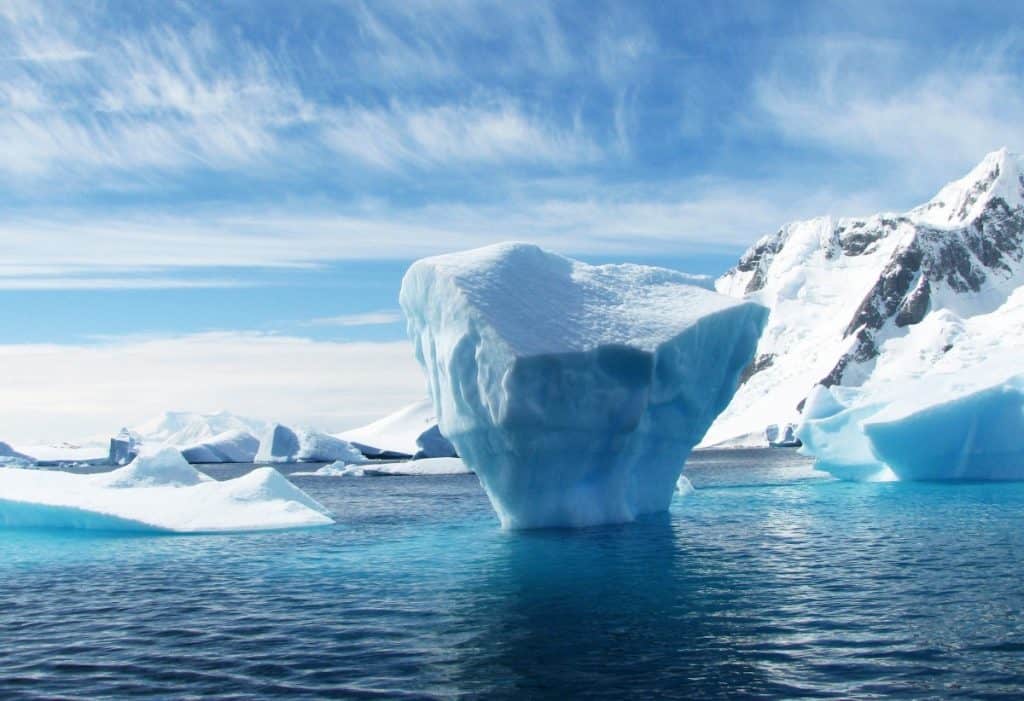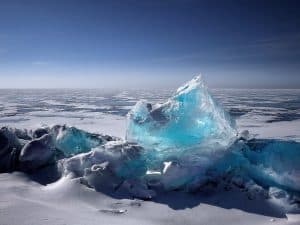
Many travelers to cold climates often wonder what water straight from icebergs tastes like. Others want to know if it’s safe to drink water from glaciers.
What does water from an iceberg taste like? Water from icebergs tastes like ancient mineral-rich mountain spring water. It has a soft hint of salt with subtle metallic notes. This water shouldn’t be consumed without boiling, filtering, and disinfecting to remove possible microbes and heavy metals.
It’s helpful to look at the science that shows us what icebergs and glaciers are made out of. Icebergs are big chunks of ice that break off from glaciers. Icebergs are made out of the same material that glaciers are. But sometimes icebergs pick up more pollution and dust from the atmosphere.
Can you drink water from icebergs?

You can drink water from icebergs if it has been properly boiled, filtered, and disinfected. The National Park Service of the United States Department of the Interior warns that you should never drink water from a natural source that hasn’t been appropriately filtered and treated, even if the water looks clean. 1
Pathogens in the water can be so small that most of the time they can’t be seen with the naked eye. But a microscope can see them easily.
Sometimes people get sick from disease-causing bacteria in untreated natural water. Campers who drink water straight from natural sources have been known to get very sick from bacteria, viruses, or parasites that came from the water.
If you’ve consumed untreated natural water and don’t feel well, it’s important to let your doctor or medical authority know as soon as possible.
Is water from an iceberg pure? All icebergs are different and contain varying materials. No two icebergs will give exactly the same type or quality of water. Regardless, you should not drink any water from untreated natural sources.
Icebergs come from glaciers. Glaciers are known to hold heavy metals, viruses, microorganisms, bacteria, atmospheric dust, and parasites. Different glaciers contain different levels of these things. Some are cleaner than others.
What does water from glaciers taste like?
Can you drink water from glaciers? When properly treated, water from glaciers tastes slightly cleaner than iceberg water (see above for iceberg water taste). Yet, it’s still important to never drink it without properly boiling, filtering, and disinfecting it.
Some glaciers contain heavy metals, microbes, viruses, dust from the atmosphere, and/or bacteria. Some people get sick from drinking untreated water.
What’s in the Water of Icebergs and Glaciers?

TARDIGRADES – Tiny little creatures, called tardigrades, have been found in glaciers. These microscopic animals are less than a millimeter in size. They look like a cross between a rhino and a puffy couch with a gas mask on. If you’re looking for the next science fiction cartoon, this bug should be the model! Their behavior is also remarkable.
- But who wants to drink tardigrades in their water? Yuck.
- Tardigrades, also known as water bears, were found by scientists on an alpine glacier. 2
- Tardigrades have gained the reputation as being the toughest animals on Earth. They can survive 30 years in freezing temperatures, under great pressure, without oxygen, and have even survived a massive dose of radiation in space! They have an amazing defense mechanism and can even survive in extreme heat for long periods of time.
CYANOBACTERIA – These little microscopic organisms have one cell. They’re known to be the oldest forms of life on the planet. They have been found in glaciers.
MICROALGAE – Microalgae are also tiny one-celled organisms that have been found in arctic glaciers. 3
- Tardigrades are known to feed on microalgae and cyanobacteria. They’re like a magnet for tardigrades (water bears). For this reason, you often see tardigrades where there are microalgae colonies on a glacier. So, it’s possible that water from glaciers could contain all of these forms of life (and more).
MERCURY – Many different studies around the world have found mercury in glaciers. A study of the Greenland Ice Cap revealed the presence of mercury. 4
- If there is mercury in some glacier ice, then it is logical to assume that some icebergs may also contain mercury. We know this because icebergs are big chunks of ice that break off from glaciers.
HEAVY METALS – The following list shows some examples of heavy metals that have been found in glacier ice near the north pole 5 :
- Iron
- Zinc
- Lead
- Copper
- Nickel
- Cadmium
VIRUSES AND BACTERIA – It’s well known in the scientific community that glaciers contain viruses and bacteria. 6
- Just knowing that there could be viruses and bacteria in glacier meltwater gives us good reason to make sure the water has been properly cleaned and treated. Some viruses and bacteria are known to make people really sick.
- Many campers have come home with stomach cramps, fevers, and horrific diarrhea after drinking untreated natural water on a camping trip. It just isn’t worth it! Make sure you are educated regarding how to clean, filter, and disinfect your camping water. The National Park Service gives guidelines on their website at this link.
HUMAN POOP – A study found bacteria from human poop in the meltwater of glacier regions. 7
- This should be enough to make anyone hesitant to drink water straight from glaciers or icebergs.
- Sometimes the bacteria that comes from human poop can make another person sick. It’s just not a good idea to be drinking this stuff. There are a lot of people who take medications and have all kinds of illnesses that are letting go of their #2 waste near glacier camps in the wild.
There are some companies that feature bottled water from glaciers. You can rest assured that their water has been properly cleaned, filtered, and disinfected. Heavy metals in glacier or iceberg water should only be a concern if the water has not been treated or bottled by a trusted company.
Not all Water from Glaciers and Icebergs is the Same
There are some icebergs and glaciers that melt off perfectly pure and clean water. Others are full of toxins and bugs. It’s not fair to say that all icebergs and glaciers are equal, because they aren’t.
Because all bodies of ice around the world are different, it’s safe to follow the guidelines of the National Park Service and never drink any natural water that hasn’t been filtered and treated. That includes icebergs and glaciers. See the first reference below if you’d like to know how the government recommends cleaning untreated natural water.
Can you drink water from glaciers in Alaska?
It’s not a good idea to drink water straight from glaciers in Alaska. Glaciers have been known to carry bacteria, viruses, atmospheric dust, heavy metals, and even remnants of human feces.
This is not to say that all glaciers in Alaska carry any or all of the above stated things. However, as a precaution, it’s always wise to only drink water from glaciers that has been properly boiled, filtered, and disinfected according to the guidelines of the National Park Service.
The same applies to icebergs. Don’t drink melted water straight from icebergs in Alaska because they likely broke off from a glacier. We know that glaciers hold all kinds of foreign materials that we don’t want to intentionally drink.
We can conclude that it’s definitely not safe or a good idea to drink water from icebergs or glaciers without proper boiling, filtration, and disinfection. It’s not worth ruining your pleasant outing in nature by coming down with some kind of sickness from the water. Be safe. Think before you act. And have a fabulous time in the great outdoors!
Carpe diem.
References:
1. U.S. Department of the Interior, National Park Service (Last updated November 29, 2017). Two Ways to Purify Water. Retrieved from: https://www.nps.gov/articles/2wayspurifywater.htm
2. Zawierucha K, Buda J, Azzoni RS et al. Water bears dominated cryoconite hole ecosystems: densities, habitat preferences and physiological adaptations of Tardigrada on an alpine glacier. Aquat Ecol. 2019; 53, 543–556. [Google Scholar]
3. Vonnahme, T. R., Devetter, M., Žárský, J. D., Šabacká, M., and Elster, J.: Controls on microalgal community structures in cryoconite holes upon high-Arctic glaciers, Svalbard. Biogeosciences. 2016; 13, 659–674. [Google Scholar]
4. Appelquist H, Jensen K O, Sevel T, Hammer C. (1978). Mercury in the Greenland Ice Sheet. Nature, 273, 657–659. [Google Scholar]
5. Karel Drbal, Josef Elster & Jiŕì Komárek (1992) Heavy metals in water, ice
and biological material from Spitsbergen, Svalbard, Polar Research, 11:2, 99-101. [Google Scholar]
6. Rassner S M E, Anesio A M, Girdwood S E, Hell K, Gokul J K, Whitworth D E, Edwards A. (2016). Can the Bacterial Community of a High Arctic Glacier Surface Escape Viral Control? Front Microbiol. 7: 956. [PMC Free Article]
7. Goodwin K, Loso M G, Braun M. (2018). Glacial Transport of Human Waste and Survival of Fecal Bacteria on Mt. McKinley’s Kahiltna Glacier, Denali National Park, Alaska. Arctic, Antarctic, and Alpine Research>An Interdisciplinary Journal Volume 44, Issue 4. [Google Scholar]
© Copyright 2021 Natural Universal Secrets. All rights reserved. Copying or distributing any portion of this article is strictly prohibited and punishable by law.
The National Park Service warns people to never drink water from natural sources that has not been properly boiled, filtered, and disinfected.
For more details, here is a link to the U.S. Department of the Interior, National Park Service: https://www.nps.gov/articles/2wayspurifywater.htm

